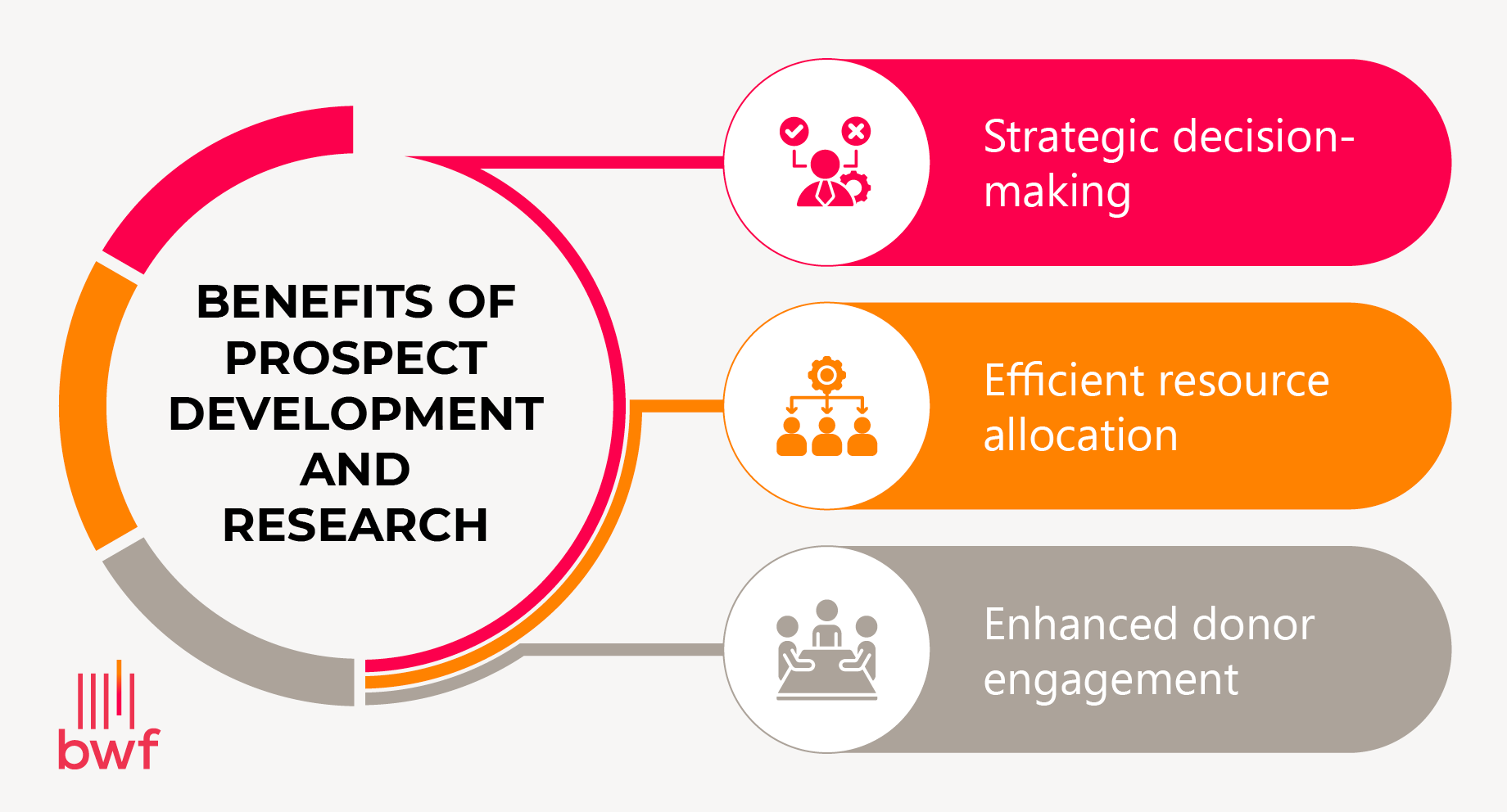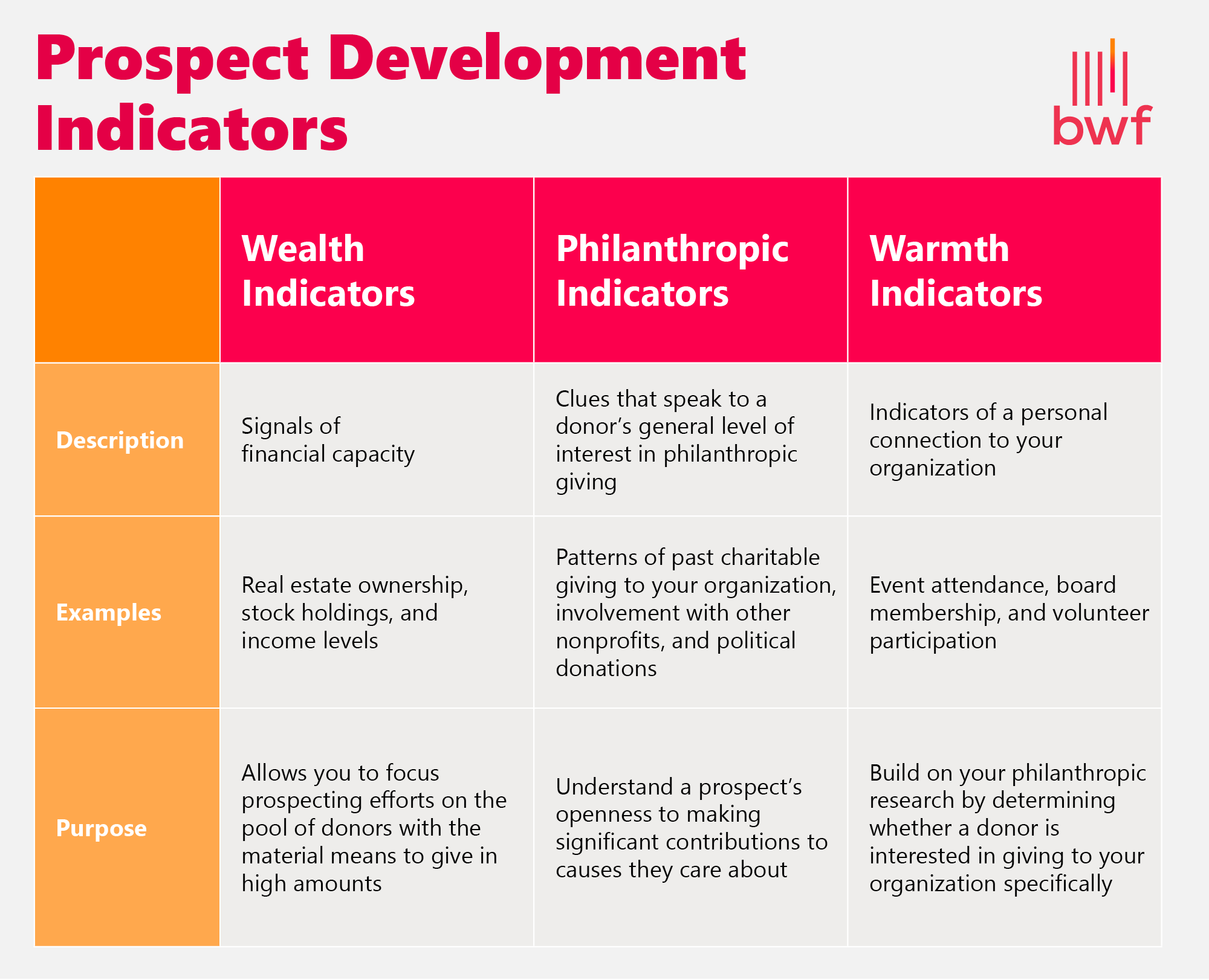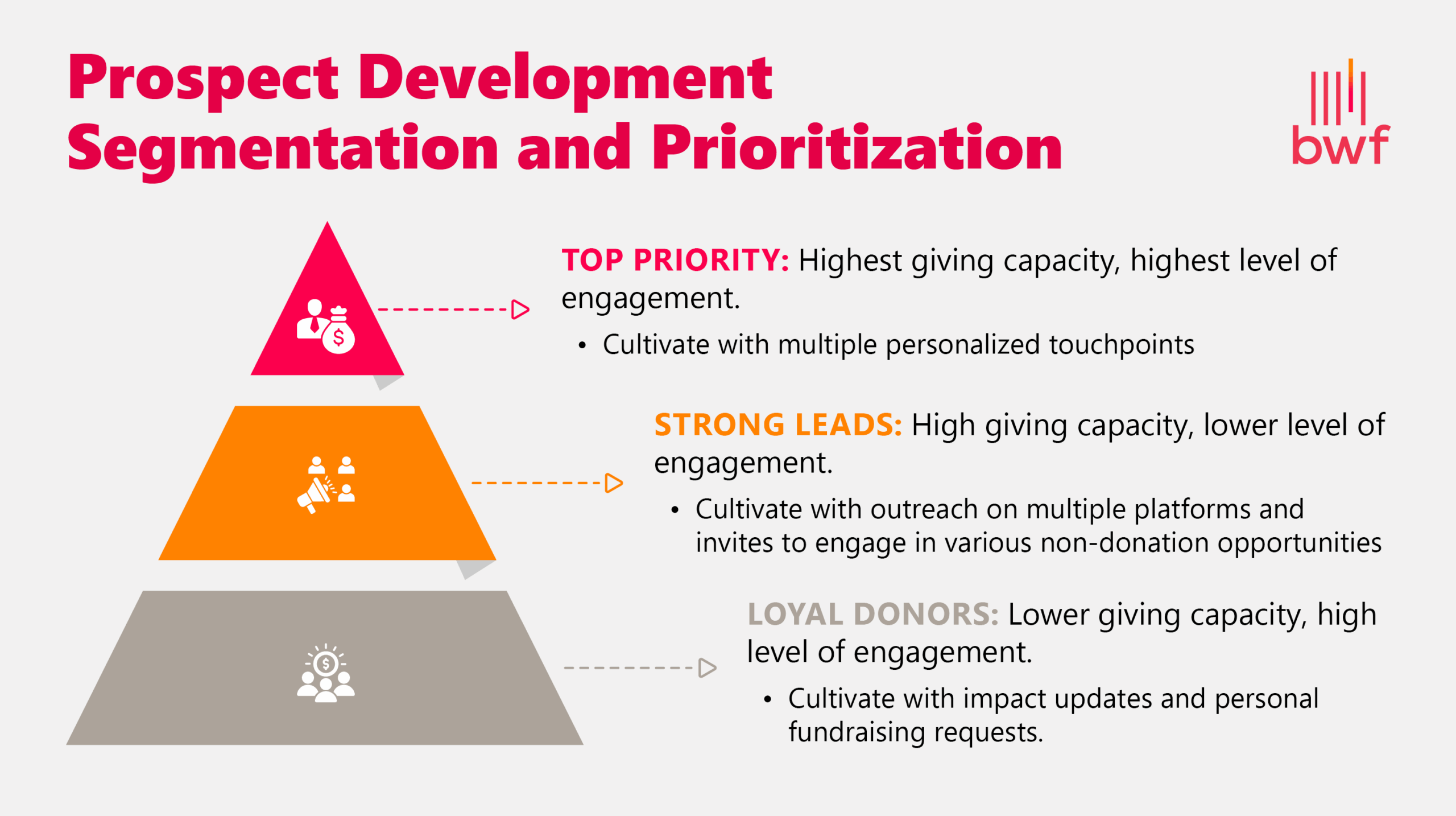Building a sustainable donor pipeline is crucial for nonprofits, and prospect development is one key strategy to achieve this goal. Did you know that a whopping 88% of the money that nonprofits raise comes from just 12% of donors? This statistic highlights the strategic necessity of prospect research in identifying major giving opportunities.
This blog will provide a comprehensive guide for development officers and other fundraisers to explore prospect development’s crucial role in fundraising. We’ll explore:
- Understanding Prospect Development Fundamentals
- Identifying Prospect Development Indicators
- The Essential Elements of a Prospect Development Strategy
- How to Customize Prospect Development to Different Contexts
Understanding Prospect Development Fundamentals
What is prospect development?
Apra defines prospect development as “the strategic arm of an organization’s fundraising operation, focusing on prospect pools and pipelines. Prospect Development professionals collaborate with gift officers and development leaders to ensure fundraising efforts are focused on working with the right donors for the right gifts at the right time (and, in many cases, with the right initiatives).”
Prospect development is a critical research tool for finding major and transformational gifts.
Prospect development in context
Prospect development is the first step of the wider three-step major donor management process:
- Prospect research – Collecting data like wealth, philanthropic indicators, and affinity for your cause.
- Portfolio management – Organizing and prioritizing prospects for fundraisers.
- Relationship management – Tracking and nurturing relationships with donors.
Prospecting is the crucial first phase in building long-term relationships with donors who can make larger gifts and are passionate about your mission. Prospect development goes hand in hand with major gift cultivation throughout the donor lifecycle.
Why does prospect development matter?
Prospect research optimizes fundraising efforts by identifying high-potential donors. This process supports:

- Strategic decision-making – Enables development teams to focus their energy on high-impact relationships.
- Efficient resource allocation – Reduces wasted time and energy on leads that don’t align with your mission.
- Enhanced donor engagement – Personalizes outreach based on data-backed insights to form stronger donor relationships.
Identifying Prospect Development Indicators
As mentioned above, you’ll identify prospects largely through the wealth, warmth, and philanthropic indicators they exhibit. Let’s look at these signifiers in closer detail.

Wealth Indicators (Capacity)
Description: Signals of financial capacity that reveal a donor’s ability to contribute at a major level.
Examples: Real estate ownership, stock holdings, and income levels.
Purpose: Identifying wealth indicators ensures that you’re developing prospects with the material means to contribute significant donations. Understanding each prospect’s level of wealth also allows you to set more accurate gift asks.
Philanthropic Indicators (Propensity)
Description: Clues that speak to a donor’s general level of interest in philanthropic giving.
Examples: Patterns of past charitable giving to other organizations, involvement with other nonprofits, and political donations.
Purpose: Philanthropic indicators demonstrate a prospect’s openness to making significant contributions to causes and organizations they care about.
Warmth Indicators (Affinity)
Description: Indicators of a personal connection to your organization and its mission
Examples: Event attendance, board membership, volunteer participation, and other meaningful interactions with your organization.
Purpose: Warmth indicators build on the information you gather through philanthropic research by determining whether a donor is interested in giving to your organization specifically.
Keep in mind that your organization’s top prospects will display all of these indicators simultaneously. A wealthy individual with no history of charitable donations or connection to your cause may not be worth spending much effort on cultivating. On the other hand, a wealthy individual with a history of charitable gifts to other local nonprofits and past involvement as a volunteer leader at your organization is deserving of careful consideration and stewardship.
In other words, it’s not just a question of whether someone can contribute a meaningful contribution to your cause—you must look deeper to understand why they would.
The Essential Elements of a Prospect Development Strategy
Your nonprofit needs an organized, strategic approach to identifying, researching, segmenting, and cultivating prospects in your audience who exhibit the indicators listed above. Use these strategies to build a well-rounded prospect development approach.
1. Conduct internal research.
The first place to start conducting prospect development is your nonprofit’s internal CRM database. The information you’ve collected on your supporters over time will provide valuable insights into which current donors are prime major donor prospects.
Start by looking for warmth indicators like:
- Recurring donations
- Event participation
- Membership duration
- Volunteer experience
- Advocacy
As you review your donor data, you should also consider past donation amounts. Committed mid-level donors are often top prospects, specifically for legacy giving. According to the Missing Middle report, over half of mid-level donors interviewed have either made a bequest to a charity (31%) or are planning to do so (23%).
2. Perform wealth and philanthropic screening.
Wealth and philanthropic screening tools can automatically scan your nonprofit’s donor database for major gift indicators. These tools combine publicly available wealth information, like real estate ownership or stock holdings, with affinity data from proprietary philanthropic databases.
Wealth screening tools allow you to identify donors who have a strong capacity to give and a genuine interest in your cause. Additionally, if you encounter individuals who are not yet in your internal database, these tools can help assess their likelihood of making significant contributions.
Also, subscribing to a donor news alert service allows you to notify your fundraising team when something occurs that makes a prospect more likely to give. For example, a donor who recently acquired a local business may be featured in a news article highlighting their new ownership. Donor news alert services will immediately let your team know so you can make a timely ask.
3. Segment and prioritize prospective donors.
After identifying individuals in your organization who can and want to contribute larger gifts, it is time to categorize these prospects into groups according to their likelihood of giving and the potential impact of their donations.
We recommend using these guidelines to sort prospects into tiers:

- Top priority: Highest giving capacity and highest level of engagement. These are your likeliest major giving prospects.
- Outreach approach: To cultivate these prospects, use a comprehensive outreach strategy with multiple personalized touchpoints. These can include one-on-one meetings with your organization’s executive director, personalized tours of your nonprofit’s facilities, and access to special event invites.
- Strong leads: High giving capacity and lower level of engagement. These individuals may require more cultivation touchpoints before deciding to give.
- Outreach approach: Leverage a multiplatform communication cadence with emails, phone calls, texts, and letters. Invite these prospects to engage in non-donation opportunities, such as volunteering or advocacy. This allows them to get to know your mission on a deeper level.
- Loyal donors: Lower giving capacity and a high level of engagement. These are great prospects for monthly and annual giving.
- Outreach approach: Spotlight recurring giving opportunities, such as your monthly giving program. Personally invite donors to engage in high-impact campaigns, such as your year-end giving efforts. Spotlight donor impact in personalized emails or impact reports to demonstrate donor value to your mission.
These strategies allow you to meet prospective donors where they are and use thoughtful touchpoints to nudge them toward a higher level of commitment to your cause.
4. Make your outreach personal.
Use the information from your donor database to ensure you align with prospects’ preferences. For example, you can send mostly email communications to a prospect who subscribes to your newsletter and actively opens and clicks on links in your email communications. This level of personalization appeals to prospects because it shows that your organization sees them as unique individuals.
Beyond aligning with prospects’ interests and needs, your organization should also seek to show potential donors how giving to your organization offers mutual benefits:
- To demonstrate the impact on your cause, highlight the positive effect of giving at different levels. For example, you could demonstrate how a $5,000 donation allows your organization to purchase new equipment for your community mobile health clinic.
- To demonstrate the impact on donors, highlight donor testimonials and the community of major and loyal donors involved in your organization’s work. Share stories from long-time donors who feel fulfilled from giving to your nonprofit. In addition, explain how donating at a higher level allows prospects to join a community of like-minded individuals working toward shared goals. Spotlight any exclusive opportunities for loyal major donors, such as special appreciation events or access to Q&As with your organization’s founder.
Show prospects that giving to your organization isn’t just a charitable gesture; it’s a true lifestyle choice that positively impacts their ability to engage with their community on a deeper level and build a long-lasting positive legacy.
5. Incorporate ethical practices into prospect development.
Your prospect development process should align with your nonprofit’s values. It should also build trust with supporters through transparency, data governance, and due diligence. Keep these best practices in mind to create an ethical, secure process:
- Conduct due diligence. Ensure that you’re only stewarding donors who can make gifts that won’t constitute a conflict of interest or contradict your nonprofit’s values.
- Ensure compliance with laws like GDPR and CCPA. These are regulations that give individuals the right to access their personal data and opt out of data collection and usage. They also require organizations to take measures to protect data through security efforts.
- Be transparent about how you use donor data. Provide a detailed privacy policy on your website and allow donors to opt out of data collection at any time.
Additionally, offer an ethical policy on your organization’s website so prospective donors can review your ethics commitments at any time.
6. Train staff on prospect development best practices.
Your nonprofit can work with a prospect development consultant to create a bespoke training program for your development and fundraising team. By equipping staff with the skills to conduct and manage prospect research independently, you’ll set your prospecting program up for long-term viability.
Create structured training that includes:
- An explanation of how your prospect research tools work
- A review of the analytical strategies your organization uses to identify, segment, and prioritize prospects
- A comprehensive overview of the ethical guidelines that development team members are required to follow
Incorporate training refreshes every few months to align on expectations, check in on progress, and work through any challenges as a team.
7. Avoid scope creep.
Scope creep is a common problem for prospect development. Prospect development teams are often viewed as liaisons between multiple departments, which can lead to various time-consuming out-of-scope tasks getting added to their plates.
To mitigate scope creep, you should:
- Clearly define the scope of your team’s purpose and communicate that purpose to the rest of your fundraising team.
- Ensure every task your prospecting team is asked to do clearly aligns with the scope of their responsibilities.
- Delegate tasks that are less appropriate for your team to other departments.
Ensure your prospect development team has a strong advocate who can clearly delineate your team’s role to the rest of your organization.
8. Partner with experts.
Working with consultants like the prospect development experts at BWF will help enrich your internal strategies and build a sustainable prospecting framework.
Our prospect development and research services include:
- Prospect identification through advanced analytics
- Wealth and philanthropic screening
- Donor profiling to help understand your prospects’ interests and level of engagement
- Prospect pipeline development
- Portfolio optimization to ensure engagement with donors who exhibit maximum fundraising potential
- Prospect research and management training to equip your team with the right tools and best practices
Our work with The Nature Conservancy demonstrates our prospect development and analytics processes in action. We supported this nonprofit with a prospect development SWOT analysis that helped evaluate current resources and needs. Then, we helped the organization create a new prospect development structure with recommendations for increasing major and principal gift funding.
How to Customize Prospect Development to Different Contexts
One-size-fits-all prospecting doesn’t work in every context—tailoring your approach based on campaign type can be more useful. Here are a few examples of different campaigns for which you can create tailored prospecting processes:
- Capital campaigns:
- Target focus of prospective development: Building a major donor pipeline from the ground up.
- Strategies to develop prospects: Use the quiet or leadership phase of your capital campaign to hold feasibility conversations, conduct personalized outreach to prospects, and provide campaign updates from your leadership.
- Annual giving:
- Target focus of prospective development: Finding mid-level donors ready to upgrade.
- Strategies to develop prospects: Send targeted communications across a variety of channels with personalized stories and impact information.
- Planned giving:
- Target focus of prospective development: Researching life-stage indicators and affinity patterns.
- Strategies to develop prospects: Hold one-on-one meetings with prospects to understand their values and charitable goals and describe the long-lasting impact of legacy donations.
The underlying best practices of prospect development (warmth and wealth screening, personalized outreach, etc.) still hold true in each of these scenarios. But these specific strategies allow you to tailor your outreach to best support each unique campaign type.
Wrapping Up
A robust prospect development program can be revolutionary for your organization. By focusing your efforts on high-potential prospects, harnessing technology and human expertise, and emphasizing ethics, you can enhance your current prospect development strategies for greater future success.
Remember that you don’t have to tackle this process independently—consult with an expert partner like BWF for customized solutions tailored to your fundraising needs.
Explore these additional resources for more information about innovative prospect development and fundraising solutions:
- AI Fundraising Use Cases: Ways to Propel Your Giving Efforts. Learn how to leverage AI tools to increase efficiency in multiple fundraising use cases.
- Mid-Level Donor Strategy: Steps to Engage and Build Trust. This guide offers tips on cultivating mid-level donors more effectively.
- Responsible AI: Equip Your Team with Ethical Best Practices. This comprehensive resource provides the top considerations for ensuring ethical AI usage.
Let’s Talk
Find out how BWF can support your prospect development and research goals.








